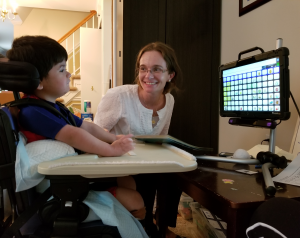 As we were reading Curious George and the Fire Fighters, Joey asked for a fire engine by saying “Fire engine” on his device and pointing to the box where I had small fire engine toys. I handed him one but he looked perturbed. “Different fire engine” he said. OK, got it, you want a different one. “Do you want big fire engine or little fire engine?” I asked in a mix of oral language and on his AAC device. He immediately looked around the room for the big fire engine, answering my question with his eye gaze. [Read more…]
As we were reading Curious George and the Fire Fighters, Joey asked for a fire engine by saying “Fire engine” on his device and pointing to the box where I had small fire engine toys. I handed him one but he looked perturbed. “Different fire engine” he said. OK, got it, you want a different one. “Do you want big fire engine or little fire engine?” I asked in a mix of oral language and on his AAC device. He immediately looked around the room for the big fire engine, answering my question with his eye gaze. [Read more…]
Mad Like He
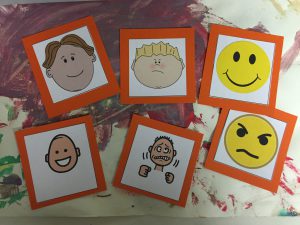 When I arrived at Joey’s house on Monday he was just waking up from a nap, and not too happy about it. We got him into his chair but he looked unimpressed as I presented him with our typical activities he normally enjoys. We started reading books, but he interrupted to tell me “mad like he.”
When I arrived at Joey’s house on Monday he was just waking up from a nap, and not too happy about it. We got him into his chair but he looked unimpressed as I presented him with our typical activities he normally enjoys. We started reading books, but he interrupted to tell me “mad like he.”
Mad like he.
I waited to see if anything was coming next. As I’ve written about before , sometimes Joey tells me a long string of words on his device and I can’t always tell how they are connected, or what story he is telling. This time though, he did not add any more words, but instead almost glared at me, waiting for my response. Mad like he.
Yes, he was mad. I could tell. I am not sure exactly what he meant by ‘like he’ but I’m pretty sure he meant it to convey just how mad he was. Not just mad. Mad like he. Mad like a character in a book? Someone in his memory? It didn’t really matter in this moment – I understood his message. He was less than pleased about our work.
Lately I’ve been surprised by Joey’s use of words with multiple meanings. When we are reading, if the book reads “the duck rode a little faster” Joey will spontaneously say little on his device. It takes me by surprise, because somehow in my mind, little on his device describes size or a concrete object. At least, that’s how I’ve introduced it to him. But he’s made the connection between size and a way to describe an intangible concept, like speed or time. I usually assume when Joey says like he means to tell me about something he likes, because that is the only way I’ve modeled it on his device. Yet Joey is always listening to those around him, and is constantly engaged with books read to him, so it makes sense that he would use like in its other meanings as well.
Although his mood did not improve much over the course of the session, he continued to use longer phrases to tell me what he wants.
“Need goat work.” We read a book about a goat, and Joey calls our activities together working, so I handed him the plastic goat and switched to that book. He was momentarily pleased, though obviously still disgruntled.
“Fire engine big where” he said later, and gazed around the room, apparently looking for his big fire engine. I usually have smaller fire engines, but I’ve used big to describe his personal one.
“brother hear goodbye” he cried, and I think he was asking for his brother who was home from spring break but playing outside. I *think* he was using hear for here, since the words sound the same to him.
Joey was mad like he for most of our session, which is very rare for him. Eventually we got him out of his chair and he cheered up. Although I hate to see Joey upset, and would never intentionally plan to upset him, I was thrilled with his use of language to tell me what he was thinking about. It was not long ago that I was laminating about trying to get Joey to use two word phrases (LINK to blog), and he was fighting me on this. Once I relaxed and stopped asking him to use the words I was giving him, he began using spontaneous, non-scripted phrases on his own. Occasionally he’ll even use the word want with me.
Incorporating Math Skills into Storybook Read Alouds
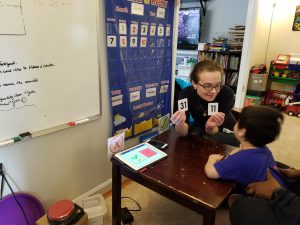 “What’s today?” I ask Joey, after we’ve counted all the numbers already posted on his wall calendar. “What comes next?” I hold up two possible choices, and every time – every time – Joey grins, stares, and then carefully moves his arm so he can clutch the card with the correct answer. It never gets old watching him proudly select the right number to put on his calendar. Although he is always correct, as his teacher I try to stay fully aware that being able to recognize what number comes next in a pattern is different than a full development of age-appropriate number sense. There are so many facets to developing mathematical thinking, and I want to be sure Joey is getting a well-rounded foundation, despite his limitations.
“What’s today?” I ask Joey, after we’ve counted all the numbers already posted on his wall calendar. “What comes next?” I hold up two possible choices, and every time – every time – Joey grins, stares, and then carefully moves his arm so he can clutch the card with the correct answer. It never gets old watching him proudly select the right number to put on his calendar. Although he is always correct, as his teacher I try to stay fully aware that being able to recognize what number comes next in a pattern is different than a full development of age-appropriate number sense. There are so many facets to developing mathematical thinking, and I want to be sure Joey is getting a well-rounded foundation, despite his limitations.
I was thrilled the other day when my Journal of Early Intervention arrived in my mailbox and included an article on how storybook read-alouds can be used to improve our preschooler’s mathematical ability. This is exactly what I hope to accomplish in my lessons with Joey. Seeing the research behind the study confirmed that Joey experiencing and practicing number sense activities throughout our sessions.
The study focused on supporting the development of three different concepts – quantity comparisons, one-to-one correspondence counting, and oral counting.
With Joey, I’m often looking for ways to count sets of objects in books. We recently read David Shannon’s Duck on a Bike (which, by the way, includes three of Joey’s favorite AAC words – duck, on, bike). As Duck rides his bike through the farm, he talks to many different farm animals. Although this is not a counting book, we can count each animal as Duck goes past. For this book I have plastic animals to represent each animal in the story, so we can line the animals up in front of Joey as Duck greets each one. This lets us be able to not just count a set of objects, but we can also watch as the line grows as we add each new animal. “Now there are four… but one more comes… and now there are… five!” At the end of Duck on a Bike, each animal finds a bike to ride. This gives us another opportunity to work on comparing amounts and matching like-sets. For this, I have a laminated picture of the animal that Velcro’s onto a laminated bike. After reading the book we play a game where we spin a wheel to determine how many bikes we get to give to the animals. If Joey spins a 2, he gets to pick up two bikes and give them to two different animals. This integrates numeral recognition, selecting a set amount, and matching sets with one to one correspondence.
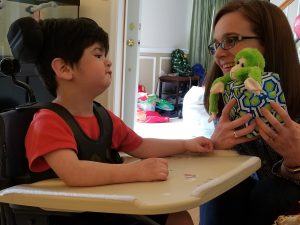 We are now reading Dear Zoo , which also gives us an opportunity to count animals. In this book a child writes to the zoo for a pet, and each time the zoo sends an animal that just isn’t right (until the very end.) Here, we can make our own line of animals that the zoo sends, to work on counting with one to one correspondence, and adding on by one to a set of objects. Although the child in the book sends back each animal after he receives it, I like to wait until we’ve collected all of the zoo’s animals, and then send them back one by one, so we can watch as the line of animals gets smaller and smaller until only the puppy is left. This lets us work on those early subtraction skills.
We are now reading Dear Zoo , which also gives us an opportunity to count animals. In this book a child writes to the zoo for a pet, and each time the zoo sends an animal that just isn’t right (until the very end.) Here, we can make our own line of animals that the zoo sends, to work on counting with one to one correspondence, and adding on by one to a set of objects. Although the child in the book sends back each animal after he receives it, I like to wait until we’ve collected all of the zoo’s animals, and then send them back one by one, so we can watch as the line of animals gets smaller and smaller until only the puppy is left. This lets us work on those early subtraction skills.
Although Joey may not be able to explain his mathematical thinking to us (and really, how many four year olds can?), he’s exploring early numeracy skills through acting out story books, reading the books, and playing with items related to the books. I am hopeful all of this will improve his math skills and give him a solid foundation as he continues to learn and grow.
Green, K, Gallagher, P, and Hart, L. (2018). Integrating mathematics and children’s literature for young children with disabilities. Journal of Early Intervention, 40, 3-10.
How important is reciprocal communication?
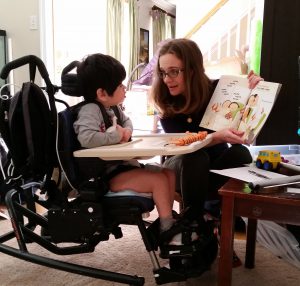 On Monday, Joey said “Dog Firetruck” on his AAC device, looked at me, and then carefully used one finger to point to the box on the floor that contained Dot the Fire Dog book and the props we use while we read aloud. Although it seemed like a small thing – two words together paired with a gesture, in turns of language development, this is a big deal. Seeing him pair language with his gestures shows that he is building an understanding of communication, and how we interact together. He can use gestures and words to communicate with me and expect that I’ll respond. [Read more…]
On Monday, Joey said “Dog Firetruck” on his AAC device, looked at me, and then carefully used one finger to point to the box on the floor that contained Dot the Fire Dog book and the props we use while we read aloud. Although it seemed like a small thing – two words together paired with a gesture, in turns of language development, this is a big deal. Seeing him pair language with his gestures shows that he is building an understanding of communication, and how we interact together. He can use gestures and words to communicate with me and expect that I’ll respond. [Read more…]
Love Fire Engines, Dogs, and Talking?
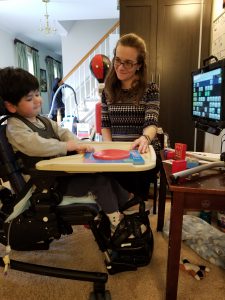
Joey loves fire trucks. Whenever I show him something red, he’ll often say fire engine on his eye gaze device after he labels it. So when I came across a fire engine book I figured I should try it with him. To be honest, the book does not have a lot of the qualities I usually look for when I’m choosing a good book to use with Joey, but it did have a dog and a fire engine. Since we are going for interactions and not quality literature, I thought we’d give it a go. [Read more…]
- « Previous Page
- 1
- …
- 27
- 28
- 29
- 30
- 31
- …
- 38
- Next Page »


